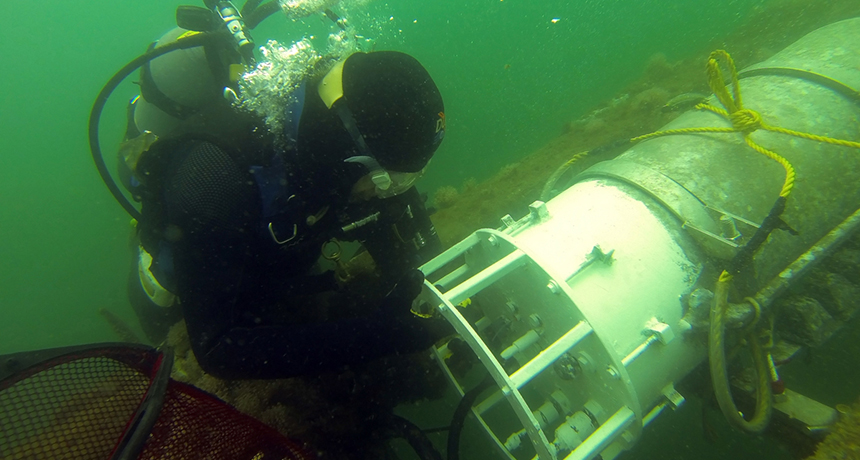
GO WITH THE FLOW Data collected by the FlowCytobot, an instrument that can identify and count cells (shown being secured underwater by a researcher), reveal that a kind of phytoplankton grows faster in warmer water, regardless of nutrients or other factors.
Sean Whelan/Woods Hole Oceanographic Institution
- More than 2 years ago
Spring brings blooms, and not just on land. Warmer waters spur growth of a tiny ocean-dwelling bacteria. More than 10 years of data collected at an unusually high-tech ocean observatory reveal that the speedy growth of the phytoplankton Synechococcus is driven by an uptick in temperature. As spring’s warmth comes earlier, so does the phytoplankton’s annual growth spurt, resulting in a shift in timing of its “blooms,” the new study shows.
“This is a surprising find,” says marine ecologist François Ribalet of the University of Washington in Seattle, who was not involved in the study. Phytoplankton respond to many environmental factors, including the availability of light and nutrients, Ribalet says. “But this work shows that it is just temperature driving the dynamics of the population. As ecologists, we always think things are very complex, but sometimes they are simple.”
The researchers, reporting in the Oct. 21 Science, also discovered that at first, tiny predators of Synechococcus keep pace with the plankton’s growth spurt, killing them as they grow. Then for unknown reasons, a lag occurs in the predators’ voracious pace. Synechococcus’s warmth-induced rapid cell division continues unabated, though, resulting in a bloom.
An elegant underwater instrument allowed the research team to uncover the link between warmer waters and earlier blooms. Called the FlowCytobot, it can spend months beneath the waves, enabling unprecedented data collection. Outfitted with a flow cytometer that uses lasers to identify and count cells in single file, the FlowCytobot perched about four meters below the water’s surface. It was attached to a communication tower that sits about a mile out to sea off the coast of Massachusetts as part of the Martha’s Vineyard Coastal Observatory. With electricity and an internet connection from the cabled tower, the team collected data over 13 years.
Typically blooms are assessed via satellite or with intermittent sampling: Researchers go out in a boat, collect water samples, and bring them back to shore for analysis, says Heidi Sosik of the Woods Hole Oceanographic Institution, co-inventor of the FlowCytobot. But except for an occasional swap of instruments, the FlowCytobot gathered continuous data as seasons came and went, nor’easters raged and waters roiled. Combining these data with a mathematical model and water temperature records showed that for each degree Celsius increase of the mean temperature in April, the spring bloom came four to five days earlier. From 2003 to 2012, the blooms were about three weeks earlier than usual; blooms then swung later, reflecting cooler springs from 2013 to 2015.
The impact of this shift in timing isn’t clear and depends in part on the fate of the Synechococcus. Ocean-dwelling phytoplankton produce about half of the atmosphere’s oxygen, and just like photosynthesizers on land, the microbes use up carbon dioxide in the process. Where that carbon ends up depends on the phytoplankton’s predators: If little grazing critters are doing most of the killing, then the phytoplankton’s carbon stays in the food chain, perhaps eventually ending up in a fish or clam. But if viruses are the main killers, the phytoplankton’s cells get torn apart, settling down as organic matter that’s degraded by other bacteria, and thus removing nutrients from the food chain.
“This is speculation, but it could mean that warmer oceans lead to tiny shifts in the food web,” Sosik says. Another unknown is what other phytoplankton may be shoved aside by the Synechococcus. “Their growth might come at the expense of other species.”







